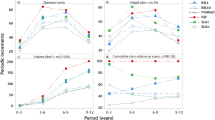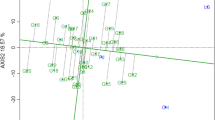Abstract
Natural black poplar (Populus nigra L.) clones sampled from river courses were tested in the arid southeast region of Turkey, using a randomized complete block field design with four replications. Clones were laid out in row plots of eight ramets each. Height and apical dominance were assessed at age one year; diameter, survival, bole straightness and branchiness were measured at age two years. Clones differed significantly in survival, growth and quality traits. The results showed that promising clones exist in natural populations. Two commercial clones out of four did not grow as fast as the top new selection clones. For bole straightness, three commercial clones had significantly lower grading scores than the top best 14 clones. Principal components analysis indicated that growth, apical dominance and branching are the most important traits distinguishing black poplar clones. Diameter had a moderate correlation (0.34) with bole straightness. Relationships between geographic variables (elevation, latitude and longitude) with growth and stem quality traits were weak. Considerable genetic variation was observed among clones for all the traits. Genetic differences among the clones accounted for 27% (survival, bole straightness) to 39% (height) of the total variance. Broad-sense individual heritability ranged from 0.27 (survival) to 0.37 (apical dominance). Clonal mean heritabilities were higher than individual heritabilities and ranged from 0.60 (survival) to 0.82 (diameter), implying considerable gain could be realized via selective improvement methods.
Similar content being viewed by others
References
Anonymous 1998. Turkish Rural Affairs Hydro Meteorological Observations Annual Report, Harran, Şanl?urfa, Turkey.
Ares A. 2002. Changes through time in traits of poplar clones in selection trials. New Forests 23: 105–119.
Birler A.S. and Koçer S., Ministry of Forestry of Turkey, Poplar Research Institute 1992. The socioeconomic importance of poplar cultivation in Southwest Anatolia Region of Turkey. Miscellaneous publications No. 1. Izmit, Turkey, 26 p.
Brown K.R., Beal F.D. and Hogan G.D. 1996. Establishment-year height growth in hybrid poplars; relations with longer-term growth. New Forests 12: 175–186.
Cagelli L. and Bisoffi S. 1994.Variability of juvenile traits within the Italian collection of Populus nigra and selection of superior clones. In: Frison E., Lefevre F., de Vries S. and Turok J. (eds), Populus nigra Network. Report of the first meeting, 3-5 October 1994, Izmit, Turkey. İPGRI, Rome, Italy 20-21. FAO, Rome, Italy 1979. Poplar and Willows inWood Production and Land Use. FAO Forestry Series No. 10. p. 34–38.
Foster G.S. 1986. Provenance variation of western cottonwood in the lower Mississippi valley. Silvae Genetica 35: 32–38.
Foster G.S., Campbell R.K. and Adams W.T. 1985. Clonal selection prospects in western hemlock combining rooting traits with juvenile height growth. Can. J. For. Res. 15: 488–493.
Heilman P.E. 1999. Planted forests: poplars. New Forests 17: 89–93.
Laing F.M., Sendak P.E. and Aleong J. 1985. Species trials for biomass production on abandoned farmland. North. J. Appl. Forestry. 2: 43–47.
Libby W.J. and Jund E. 1962. Variance associated with cloning. Heredity 17: 533–540.
Lo M.H., Abrahamson L.P., White E.H. and Manion P.D. 1995. Early measures of basal area and canker disease predict growth potential of some hybrid poplar clones. Can. J. For. Res. 25: 1113–1118.
SAS Institute Inc. 1989. SAS/STAT User's Guide. 4th edn. SAS Institute Inc., Cary, NC, 846 p. 2, Ref: version 6.
Sokal R.R. and Rohlf F.J. 1995. Biometry. 3rd edn. W.H Freeman and Company, New York, 887 p.
Steenackers J., Steenackers V., Van Acker J. and Stevens M. 1993. Stem form, volume and dry matter production in a twelve-year-old circular Nelder plantation of Populus trichocharpa x deltoides Beaupre. For. Cron. 69: 730–735.
Stonecypher R.W. and McCullough R.B. 1986. Estimates of additive and non-additive genetic variances from a clonal diallel of Douglas-fir Pseudotsuga mensiesii (Mirb.) Franco. P. 211-227 in IUFRO Conference. A joint meeting of working parties on breeding theory, progeny testing, seed orchards. Conference proceedings. October 13-17, Williamsburg, VA.
Toplu F. 1996. Breeding and conservation of genetic resources of black poplar (Populus nigra L.) in th Turkey. 20 Session of the International Poplar Commission. Budapest, Hungary, 1-4 October 1996. p 623.
Tunçtaner K. 1993. Conservation and utilization of poplar and willow genetic resources in Turkey. Publication No. 3. Poplar Research Institute, İzmit, Turkey, 23 p.
Tunçtaner K. 1995. Conservation of genetic resources of Populus nigrain Turkey. In: Frison E., Lefevre F., de Vries S. and Turok J. (eds), Populus nigra network. Report of the first meeting, 3-5 October 1994, İzmit, Turkey. IPGRI, Rome, Italy.
Zobel B. and Talbert J. 1984. Applied Forest Tree Improvement. John Wiley Sons, 505 p.
Author information
Authors and Affiliations
Corresponding author
Rights and permissions
About this article
Cite this article
Isik, F., Toplu, F. Variation in juvenile traits of natural black poplar (Populus nigra L.) clones in Turkey. New Forests 27, 175–187 (2004). https://doi.org/10.1023/A:1025071515826
Issue Date:
DOI: https://doi.org/10.1023/A:1025071515826




